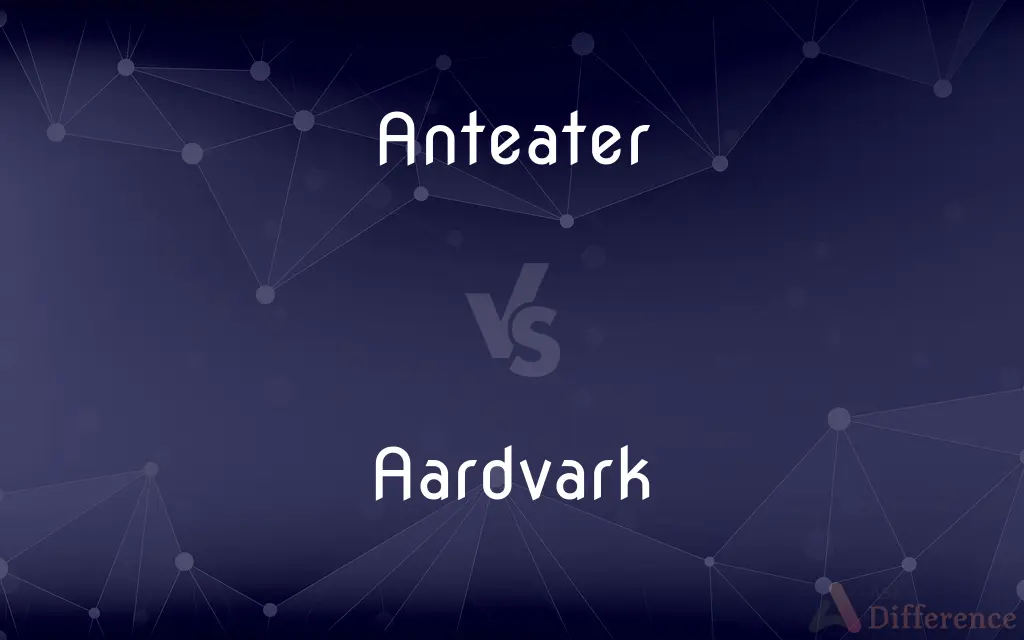Anteater vs. Aardvark — What's the Difference?
By Tayyaba Rehman — Updated on October 25, 2023
Anteaters are South and Central American mammals that eat ants and termites, while aardvarks are African mammals with a pig-like snout that also eat ants and termites.

Difference Between Anteater and Aardvark
Table of Contents
ADVERTISEMENT
Key Differences
"Anteater" generally refers to any of the four species found primarily in South and Central America. These creatures have long, slender snouts and use their tongues to capture ants and termites. In contrast, the "Aardvark" is a burrowing, nocturnal mammal native to Africa, distinguished by its pig-like snout.
The term "Anteater" is often associated with its signature elongated snout and a tongue that can be extended up to 2 feet. These adaptations make it adept at consuming ants and termites from nests. Meanwhile, the "Aardvark" has a shorter, more rounded snout and uses both its tongue and strong claws to access its prey.
One of the remarkable features of an "Anteater" is its lack of teeth. Instead, it relies on its specialized tongue and the strong muscles of its stomach to digest food. On the other hand, the "Aardvark" does have teeth, though they lack enamel and continuously grow throughout its life.
Both the "Anteater" and the "Aardvark" have evolved to have a diet primarily consisting of ants and termites. However, where the "Anteater" primarily uses its tongue to fish out its prey, the "Aardvark" digs into the ground with its powerful claws to reach termite mounds and ant hills.
Physically, "Anteaters" have a more elongated appearance, with long bushy tails, while "Aardvarks" are more stout with a hunched back and a tail that tapers to a point. This difference in physical structure points to their adaptations to their respective environments.
ADVERTISEMENT
Comparison Chart
Geographical Range
South and Central America
Africa
Snout Shape
Long and slender
Short and pig-like
Teeth
Lacks teeth
Has continuously growing teeth without enamel
Dietary Adaptation
Extended tongue for fishing out prey
Powerful claws for digging and a tongue to capture prey
Physical Appearance
Elongated with bushy tail
Stout with a tapered tail
Compare with Definitions
Anteater
An animal with a distinctive elongated snout.
The anteater's snout allows it to navigate inside ant hills.
Aardvark
A burrowing mammal with strong claws.
The aardvark's burrows provide shelter for various other animals.
Anteater
A mammal that primarily feeds on ants and termites.
The anteater used its long tongue to gather ants from the nest.
Aardvark
An animal with a unique, pig-like snout.
The aardvark's snout is ideal for sniffing out and consuming its prey.
Anteater
A creature found mainly in South and Central America.
Tourists were excited to spot an anteater in the Brazilian rainforest.
Aardvark
A nocturnal mammal native to Africa that feeds on ants and termites.
The aardvark dug into the termite mound during the night.
Anteater
A mammal without teeth, relying on its tongue and stomach muscles for digestion.
Despite having no teeth, the anteater efficiently consumes its prey.
Aardvark
The only extant member of the order Tubulidentata.
As a member of Tubulidentata, the aardvark is truly one of a kind.
Anteater
A creature belonging to the suborder Vermilingua.
The anteater is one of the few mammals classified under Vermilingua.
Aardvark
The aardvark ( ARD-vark; Orycteropus afer) is a medium-sized, burrowing, nocturnal mammal native to Africa. It is the only living species of the order Tubulidentata, although other prehistoric species and genera of Tubulidentata are known.
Anteater
Anteater is a common name for the four extant mammal species of the suborder Vermilingua (meaning "worm tongue") commonly known for eating ants and termites. The individual species have other names in English and other languages.
Aardvark
A nocturnal badger-sized burrowing mammal of Africa, with long ears, a tubular snout, and a long extensible tongue, feeding on ants and termites.
Anteater
Any of several Central and South American mammals of the suborder Vermilingua that lack teeth and feed on ants and termites, especially the giant anteater.
Aardvark
A burrowing mammal (Orycteropus afer) of sub-Saharan Africa, having a stocky body, large ears, a long tubular snout, and powerful digging claws for feeding on ants and termites.
Anteater
Any of several other animals, including the echidna, aardvark, and pangolin, that feed on ants.
Aardvark
The nocturnal, insectivorous, burrowing, mammal Orycteropus afer, of the order Tubulidentata, somewhat resembling a pig, common in some parts of sub-Saharan Africa.
The aardvark burrows in the ground and feeds mostly on termites, which it catches with its long, slimy tongue.
Anteater
Any of several animals of South and Central America, in suborder Vermilingua, which are noted for eating ants and termites which they catch with their long sticky tongues.
Aardvark
An edentate mammal, of the genus Orycteropus (Orycteropus afer), somewhat resembling a pig, common in some parts of Southern Africa. It is a nocturnal ungulate, burrows in the ground with its powerful claws, and feeds entirely on ants and termites, which it catches with its long, extensile, slimy tongue. It is the sole extant representative of the order Tubulidentata.
Anteater
Any of some other not closely related species that feed with ants, including pangolin (scaly anteater), echidna (spiny anteater), aardvark and numbat (banded anteater).
Aardvark
Nocturnal burrowing mammal of the grasslands of Africa that feeds on termites; sole extant representative of the order Tubulidentata
Anteater
Toothless mammal of southern Africa and Asia having a body covered with horny scales and a long snout for feeding on ants and termites
Aardvark
A creature with continuously growing teeth lacking enamel.
The aardvark's unique teeth are adapted to its diet.
Anteater
Any of several tropical American mammals of the family Myrmecophagidae which lack teeth and feed on ants and termites
Anteater
Nocturnal burrowing mammal of the grasslands of Africa that feeds on termites; sole extant representative of the order Tubulidentata
Anteater
Small Australian marsupial having long snout and strong claws for feeding on termites; nearly extinct
Anteater
New Guinea echidnas
Anteater
Burrowing spine-covered monotreme of Australia having a long snout and claws for hunting ants and termites
Common Curiosities
Do both "Anteaters" and "Aardvarks" eat ants?
Yes, both primarily feed on ants and termites.
How does an "Anteater" capture its prey?
An anteater uses its long, extended tongue to gather ants and termites.
What's unique about the "Aardvark's" teeth?
Aardvark teeth lack enamel and grow continuously.
Where is the "Aardvark" native to?
The aardvark is native to Africa.
Are "Anteaters" and "Aardvarks" closely related species?
Despite some similarities, they are not closely related in the animal kingdom.
Are there different species of "Anteaters"?
Yes, there are four main species of anteaters.
Which continents can you find the "Anteater" on?
Anteaters are primarily found in South and Central America.
Can you find "Anteaters" in Africa?
No, anteaters are not native to Africa; that's where you'd find aardvarks.
What's the primary activity time for an "Aardvark"?
Aardvarks are mainly nocturnal creatures.
How does an "Aardvark" access ants and termites?
Aardvarks use their powerful claws to dig into ant hills and termite mounds.
Do "Anteaters" have teeth?
No, anteaters lack teeth and use their tongue and stomach for digestion.
Do "Anteaters" and "Aardvarks" have similar predators?
Due to their different geographical locations, they face different sets of predators.
Is the "Aardvark" endangered?
As of the last update, aardvarks are not classified as endangered, but they face threats from habitat loss.
How long is an "Anteater's" tongue?
An anteater's tongue can extend up to 2 feet.
Can "Anteaters" and "Aardvarks" be kept as pets?
Generally, they are not suitable as pets due to their specific needs and wild nature.
Share Your Discovery

Previous Comparison
Incentivize vs. Incent
Next Comparison
Realty vs. RealityAuthor Spotlight
Written by
Tayyaba RehmanTayyaba Rehman is a distinguished writer, currently serving as a primary contributor to askdifference.com. As a researcher in semantics and etymology, Tayyaba's passion for the complexity of languages and their distinctions has found a perfect home on the platform. Tayyaba delves into the intricacies of language, distinguishing between commonly confused words and phrases, thereby providing clarity for readers worldwide.














































